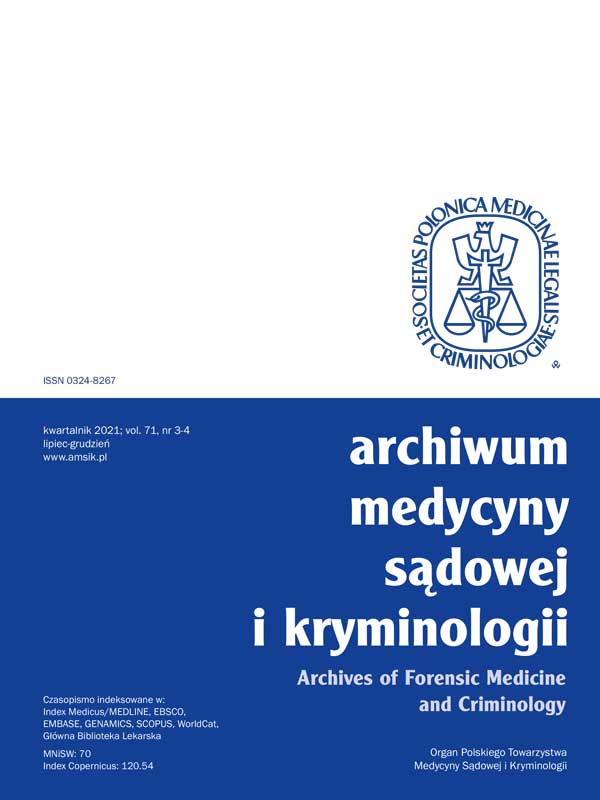Znaczenie ekspertyzy toksykologicznej dla wymiaru sprawiedliwości w aspekcie historycznym i współczesnym
The importance of the quality of toxicological expertise for the need of the judiciary in the historical and contemporary aspect
Author(s): Małgorzata Kłyś, Sebastian RojekSubject(s): Law, Constitution, Jurisprudence, Criminal Law, Criminology
Published by: Wydawnictwo Uniwersytetu Jagiellońskiego
Keywords: toxicological expertise; poisons; methodology in toxicology; standards in forensic toxicology
Summary/Abstract: [The history of humanity is closely related to the use of various poisons, different in each epoch. They served different purposes for centuries. In addition to being a remedy for various ailments and diseases, they also helped to bear the hard life of a person thanks to the possibility of causing mental elation, making it more bearable. They were also used to kill other people, most often for very low motives. The number of poisons existing in particular stages of civilization has been systematically increasing, reaching the number of 100,000 – 500,000 toxicologically active compounds in modern times, with the generally estimated number of known chemical compounds at the level of about 240 million. The research work of thinkers and people of progress is a counterbalance to the evil deeds of poisoners in antiquity and the Middle Ages. These works appeared in the late Middle Ages and are continued in various forms until the present day. As a result of these works, modern toxicological forensic expertise has been developed. However, before it appeared in its modern shape, it had to go through a very difficult development path, which lasted continuously for several centuries. Modern toxicological expertise, based on a highly specialized instrumental methodology, operating with high methodological standards, is the achievement of many generations. These standards have now become a requirement for expert works of our times, and failure to comply with them is treated as a malpractice. This work is a review of the types of poisons and reports in terms of the development and application of toxicological forensic expertise for the purposes of the judiciary. ]Historia życia ludzkości jest ściśle związana z używaniem rozmaitych trucizn, różnych w poszczególnych epokach. Służyły przez wieki różnym celom. Oprócz tego, że były lekarstwem na rozmaite dolegliwości i choroby, pomagały też unieść ciężki żywot człowieka dzięki możliwości wywoływania mentalnych uniesień, czyniąc go znośniejszym. Wykorzystywane były także do zabijania drugiego człowieka, najczęściej z bardzo niskich pobudek. Liczba istniejących trucizn w poszczególnych etapach cywilizacji ulegała systematycznemu powiększaniu, dochodząc w czasach współczesnych do liczby 100 000 – 500 000 związków chemicznych toksykologicznie czynnych, przy oszacowanej ogólnie liczbie znanych związków chemicznych na poziomie około 240 milionów. Przeciwwagę niecnych czynów trucicieli w epoce starożytności i średniowiecza stanowią prace badawcze myślicieli i ludzi postępu. Prace te pojawiły się w epoce późnego średniowiecza i są kontynuowane w różnych formach do czasów współczesnych. W wyniku tych prac ukształtowała się współczesna toksykologiczna ekspertyza sądowa. Zanim pojawiła się jednakże we współczesnym kształcie musiała przejść bardzo trudną drogę rozwojową, co trwało nieprzerwanie kilka wieków. Współczesna ekspertyza toksykologiczna, opierająca się na wysoce specjalistycznej metodyce instrumentalnej, operująca wysokimi standardami metodologicznymi, jest dorobkiem wielu pokoleń. Owe standardy stały się obecnie wymogiem stawianym pracom eksperckim naszych czasów, a ich nie dochowanie natomiast jest traktowane jako błąd w sztuce. Niniejsza praca jest przeglądem rodzajów trucizn i doniesień w aspekcie rozwoju i zastosowania toksykologicznej ekspertyzy sądowej dla potrzeb wymiaru sprawiedliwości. [The history of humanity is closely related to the use of various poisons, different in each epoch. They served different purposes for centuries. In addition to being a remedy for various ailments and diseases, they also helped to bear the hard life of a person thanks to the possibility of causing mental elation, making it more bearable. They were also used to kill other people, most often for very low motives. The number of poisons existing in particular stages of civilization has been systematically increasing, reaching the number of 100,000 – 500,000 toxicologically active compounds in modern times, with the generally estimated number of known chemical compounds at the level of about 240 million. The research work of thinkers and people of progress is a counterbalance to the evil deeds of poisoners in antiquity and the Middle Ages. These works appeared in the late Middle Ages and are continued in various forms until the present day. As a result of these works, modern toxicological forensic expertise has been developed. However, before it appeared in its modern shape, it had to go through a very difficult development path, which lasted continuously for several centuries. Modern toxicological expertise, based on a highly specialized instrumental methodology, operating with high methodological standards, is the achievement of many generations. These standards have now become a requirement for expert works of our times, and failure to comply with them is treated as a malpractice. This work is a review of the types of poisons and reports in terms of the development and application of toxicological forensic expertise for the purposes of the judiciary. ]
Journal: Archiwum Medycyny Sądowej i Kryminologii
- Issue Year: 71/2021
- Issue No: 3-4
- Page Range: 95-107
- Page Count: 13
- Language: Polish

